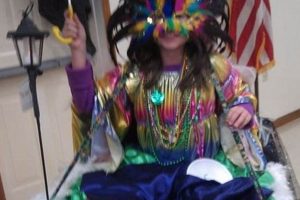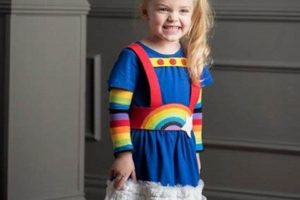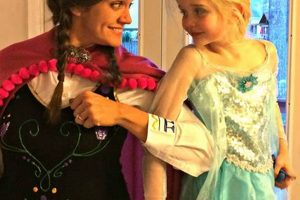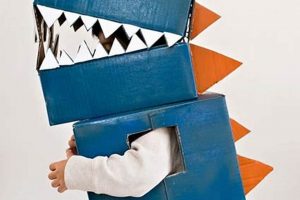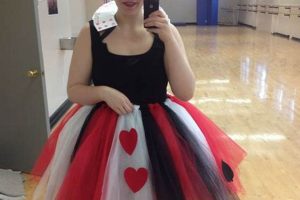Creating a homemade representation of the iconic yellow-gowned Disney character allows for personalization and cost-effectiveness. This undertaking involves crafting or repurposing elements to emulate the character’s distinctive look, such as a golden dress, accessories, and hairstyle. Examples include sewing a custom gown, altering a pre-existing dress, or styling hair to match the character’s signature updo.
The advantage of constructing such attire lies in the capacity to tailor the design to specific preferences and body types, yielding a unique and often more affordable alternative to commercially available versions. Historically, self-made character portrayals have been a popular form of creative expression, allowing individuals to engage more deeply with beloved stories and characters. The practice encourages resourcefulness, skill development, and a personalized connection to the representation.
The following sections will explore the necessary materials and techniques for constructing a satisfactory representation, considering options for dress creation, accessory sourcing, and hairstyle replication. Emphasis will be placed on approaches that are adaptable to various skill levels and budgets, ensuring the final product effectively evokes the character’s inherent charm and recognizability.
Crafting a Princess Belle-Inspired Garment
Achieving a convincing representation of the character’s iconic attire requires careful planning and execution. The following guidelines offer insights into key aspects of the construction process.
Tip 1: Prioritize Fabric Selection: The choice of fabric is paramount. A gold or yellow satin, brocade, or a similar material with a subtle sheen effectively captures the character’s elegant aesthetic. Consider the fabric’s drape and weight to ensure a flattering silhouette.
Tip 2: Utilize Existing Patterns as a Foundation: Modifying an existing dress pattern can streamline the construction process. Select a pattern with a similar bodice and skirt shape, then adapt it to incorporate the distinctive details of the character’s dress, such as the off-the-shoulder neckline and full skirt.
Tip 3: Emphasize Accurate Color Matching: Strive for accurate color matching to capture the character’s signature look. Bring reference images to fabric stores to ensure the chosen material closely resembles the shade of yellow depicted in the animated film.
Tip 4: Incorporate Layers for Volume and Depth: Adding layers to the skirt, such as tulle or crinoline, enhances its volume and creates a more dramatic effect. This technique contributes to the overall grandeur of the representation.
Tip 5: Focus on the Bodice Detailing: The bodice requires meticulous attention to detail. Consider incorporating elements such as subtle ruching, pleating, or lace appliques to enhance its visual appeal. Accurate shaping and a well-fitted bodice are crucial for an authentic portrayal.
Tip 6: Consider Alternative Closure Methods: Rather than traditional zippers, explore alternative closure methods such as hook-and-eye closures or corsetry. These methods can contribute to a more historically accurate and aesthetically pleasing finish.
Tip 7: Accessorize with Precision: Select accessories that complement the dress. A well-chosen pair of gloves, a delicate necklace, and a meticulously styled wig or hairstyle are essential components of a complete and convincing representation.
These tips provide a framework for successfully constructing a visually compelling and recognizable representation. Careful consideration of these elements will contribute to a final product that effectively captures the character’s essence and charm.
The subsequent section will delve into specific techniques for achieving a polished and professional final appearance, with an emphasis on finishing touches and overall presentation.
1. Fabric
The selection of fabric, considering both its color and texture, exerts a substantial influence on the overall success of a self-constructed Princess Belle representation. The correct hue of yellow, ranging from a soft gold to a vibrant daffodil, directly impacts the costume’s recognizability. A shade too pale or too saturated deviates from the character’s established aesthetic. Similarly, the fabric’s texturewhether a smooth satin, a subtly shimmering brocade, or a more matte crepeaffects the costume’s perceived quality and elegance. For instance, using inexpensive, coarse fabric can detract from the desired impression of royalty, regardless of the pattern’s accuracy or the skill of the construction.
The interplay between color and texture further determines the visual impact. A highly reflective fabric like satin, in the appropriate shade of yellow, captures light in a way that mimics the character’s ballgown from the animated film, creating a sense of grandeur. Conversely, a matte fabric, even in the correct color, absorbs light, resulting in a less dramatic and potentially less authentic appearance. Considerations extend to the fabric’s weight and drape; a heavy fabric may not flow gracefully, while a lightweight fabric might lack the necessary structure to hold the skirt’s shape. The choice of under layers, such as tulle or crinoline, also impacts the final texture and volume. These layers, while not directly visible, contribute to the overall structure and form of the costume.
Therefore, careful deliberation regarding both the color and texture of the fabric is paramount. Compromising on these elements can undermine the effectiveness of the entire endeavor. A well-chosen fabric, embodying the character’s established color palette and possessing a texture that enhances the costume’s elegance, contributes significantly to a polished and recognizable representation. Overlooking this aspect can lead to a final product that fails to capture the essence of the character, diminishing the overall impact of the self-made costume.
2. Pattern
The success of a do-it-yourself Princess Belle costume hinges significantly on the accuracy of its silhouette. The pattern serves as the foundational blueprint for replicating the character’s distinctive ballgown. An inaccurate pattern, even with meticulous fabric selection and skilled construction, will ultimately fail to achieve a recognizable and convincing representation. The characteristic elements of Belle’s gown, such as the off-the-shoulder neckline, fitted bodice, and full, flowing skirt, are all defined by the underlying pattern. Deviations from these elements, caused by an ill-fitting or poorly drafted pattern, will alter the costume’s shape and detract from its visual fidelity. For instance, a pattern that produces a skirt lacking sufficient volume or a bodice that fits improperly will distort the overall silhouette, rendering it dissimilar to the original design. This is because visual recognition relies heavily on accurately recreating the fundame
ntal shape and proportions of the character’s clothing.
Numerous examples illustrate the importance of pattern accuracy. Consider instances where individuals attempted to adapt existing dress patterns without properly accounting for the specific details of Belle’s gown. The resulting costumes often exhibit discrepancies in the neckline shape, skirt fullness, or bodice length, ultimately diminishing the costume’s resemblance to the original character. Furthermore, the pattern’s precision directly influences the ease of construction. A well-drafted pattern will provide clear instructions, accurate markings, and properly aligned pieces, facilitating a smoother and more efficient sewing process. Conversely, a flawed pattern can lead to fitting issues, construction errors, and ultimately, a less polished and professional final product. The impact extends beyond aesthetics; a poorly fitting costume can restrict movement and reduce comfort, affecting the wearer’s overall experience.
In conclusion, the pattern’s role in establishing an accurate silhouette is paramount in creating a successful homemade Princess Belle costume. The pattern serves as the foundation upon which all other elements are built, and its accuracy directly impacts the costume’s recognizability, construction ease, and overall visual appeal. Potential challenges include sourcing a reliable pattern or adapting an existing one to achieve the desired silhouette. However, prioritizing pattern accuracy ultimately contributes to a more convincing and satisfying final product. A deep understanding of pattern drafting and adaptation is an essential skill for effective execution of this project.
3. Accessories
The impact of accessories on the overall success of a self-constructed Princess Belle costume is significant; these details transcend mere ornamentation to become pivotal components of character recognition. The absence of key accessories or the inclusion of inaccurate ones directly diminishes the costume’s effectiveness. For example, a yellow ballgown, however well-constructed, lacks immediate association with the character without the inclusion of elements such as long gloves, a delicate necklace, or a symbolic rose. These accessories serve as visual cues, triggering instant recognition and enhancing the overall impression of authenticity. Without them, the creation risks being perceived as merely a yellow dress, failing to embody the specific character.
Furthermore, the choice of accessories allows for nuanced interpretation and personalized expression within the established framework of the character’s visual representation. Consider the option of incorporating a book, referencing Belle’s love of reading, or a simple hair ribbon that complements the dress’s color palette. These small details demonstrate a deeper understanding of the character and add a layer of sophistication to the costume. Conversely, neglecting these finer points can result in a generic and less compelling final product. The deliberate selection and accurate portrayal of accessories elevate the construction from a simple dress to a comprehensive character interpretation, thus emphasizing the importance of thoughtful planning and execution in this phase of the creation process. This understanding provides a practical framework for achieving a higher level of accuracy and creativity.
In summary, accessories represent a crucial element in achieving a successful representation within the realm of “diy princess belle costume” design. Their presence or absence directly influences recognizability. Therefore, focusing on accessory selection ensures a complete portrayal, surpassing a simple dress through critical detail and character embodiment. Challenges lie in sourcing accurately representative items within budget or skillset limitations, however the attention towards this ensures a cohesive design.
4. Hair
The coiffure forms an integral facet of a credible homemade representation of the Disney character Princess Belle. The character’s hairstyle, typically depicted as a sophisticated updo incorporating curls, braids, or other ornate arrangements, is as instantly recognizable as her distinctive yellow gown. An inaccurate hairstyle, even when paired with an otherwise well-executed costume, detracts significantly from the overall visual coherence. This is because the hairstyle serves as a key identifier, reinforcing the character’s established aesthetic and conveying a sense of elegance and refinement. A deviation from this recognized style disrupts the visual harmony, diminishing the costume’s effectiveness in portraying the intended character.
Consider, for example, the scenario where an individual invests considerable effort in creating a precisely accurate replica of Belle’s ballgown but neglects to address the hairstyle. If the wearer sports a modern, casual hairstyle, the overall effect is incongruous, creating a visual disconnect between the dress and the hairstyle. This disconnect undermines the intended character portrayal. Conversely, a meticulously styled updo, even when paired with a simpler, less elaborate gown, can elevate the costume’s perceived authenticity. The hairstyle therefore holds a disproportionate influence on the final product’s success. Tutorials and instructional resources abound, demonstrating techniques for achieving various versions of Belle’s iconic hairstyle, ranging from relatively simple adaptations to more intricate recreations. The accessibility of these resources underscores the feasibility of achieving a satisfactory hairstyle even with limited hairstyling experience.
In conclusion, the “Hair: Signature Style” component is essential for ensuring an effective design as part of “diy princess belle costume.” Achieving fidelity of the hairstyle ensures the design does not fall short of character recognition as the design aims. Challenges that may arise include matching hair color and replicating complex up-dos, but addressing these ensures a complete and cohesive character design. The effort spent will enhance the overall authenticity of the self-made costume, therefore, further emphasizing and ensuring attention is given to the “Hair: Signature Style” for the Princess Belle Design.
5. Construction
Durable assembly forms a critical, often underestimated, component of a successful self-constructed Princess Belle costume. While visual appeal and stylistic accuracy are essential, a poorly constructed garment, prone to tearing or structural failure, negates the effort invested in its aesthetic design. Therefore, the durability of the assembly directly impacts the costume’s longevity, wearability, and overall value.
- Seam Reinforcement
Proper seam reinforcement is crucial, particularly in areas subject to stress, such as the bodice seams and skirt attachment points. Utilizing techniques like double stitching, serging, or employing interfacing to stabilize fabric edges prevents fraying and seam separation. Failure to reinforce seams leads to premature damage, requiring frequent repairs or rendering the costume unusable. Examples include reinforcing the zipper insertion to withstand repeated closures and openings.
- Fabric Stability
Fabric selection and stabilization techniques contribute significantly to the costume’s s
tructural integrity. Choosing fabrics with inherent durability, such as heavier satins or brocades, provides a stronger foundation. Interfacing, fusible or sew-in, adds stiffness and support to areas like the bodice, preventing stretching or distortion. Using appropriate interfacings provides stability to prevent stretching and tearing over time. - Fastening Security
Secure fastening mechanisms, including zippers, hooks, and buttons, are essential for ensuring the costume remains intact during wear. Employing high-quality fasteners and reinforcing their attachment points prevents malfunctions that could compromise the costume’s appearance or functionality. For example, using heavy-duty hooks and eyes on the bodice provides a secure closure that can withstand movement.
- Finishing Techniques
Proper finishing techniques, such as hemming and edge binding, protect the fabric from fraying and enhance the costume’s overall appearance. Neat, well-executed finishes contribute to the costume’s professional aesthetic and extend its lifespan by preventing wear and tear. Hand-stitched hems provide a finished design that is more sturdy compared to simpler sewing techniques.
In summation, a focus on durable assembly is vital for a satisfying “diy princess belle costume” creation. The structural integrity of a homemade representation directly influences its longevity, wearability, and ultimately, its perceived value. Overlooking construction techniques in favor of purely aesthetic considerations will lead to a costume that, while visually appealing initially, will prove unsustainable over time. Therefore, prioritizing the durability of the assembly alongside visual accuracy is essential for creating a worthwhile and lasting project.
Frequently Asked Questions
The subsequent section addresses frequently encountered inquiries regarding the creation of a self-made Princess Belle costume. The objective is to clarify common points of confusion and provide concise, authoritative responses.
Question 1: What is the recommended fabric for emulating Princess Belle’s ballgown?
Satin, brocade, or a similar fabric exhibiting a slight sheen are generally considered suitable for replicating the character’s iconic dress. Emphasis should be placed on achieving an accurate shade of yellow or gold.
Question 2: Is prior sewing experience necessary for undertaking a DIY Princess Belle costume project?
While not strictly mandatory, some level of sewing proficiency is highly recommended. Individuals lacking prior experience may consider simpler costume variations or seek assistance from experienced sewers.
Question 3: What are the most cost-effective approaches to sourcing materials for a DIY Princess Belle costume?
Repurposing existing garments, utilizing discount fabric stores, and searching for sales or clearance items are effective methods for reducing material costs. Alternatives include borrowing accessories, such as gloves or jewelry, from acquaintances.
Question 4: How can the skirt of a DIY Princess Belle costume be made to achieve the desired fullness and volume?
Incorporating layers of tulle, crinoline, or similar stiff fabrics beneath the outer layer of the skirt is effective for achieving a voluminous silhouette. The number of layers and their respective stiffness can be adjusted to achieve the desired level of fullness.
Question 5: What are the recommended methods for replicating Princess Belle’s signature updo hairstyle?
Numerous tutorials and instructional resources are available online, demonstrating techniques for creating various iterations of Belle’s hairstyle. These resources often provide step-by-step guidance, catering to varying skill levels.
Question 6: How can a DIY Princess Belle costume be made durable and long-lasting?
Reinforcing seams, utilizing high-quality fasteners, and employing proper finishing techniques are essential for ensuring the costume’s durability. Selecting sturdy fabrics and implementing appropriate stabilization methods further contribute to its longevity.
A comprehensive understanding of these answers can provide a solid foundation for any aspiring costume creator by managing common difficulties.
The following section offers examples to solidify an understanding of achieving success in design of “diy princess belle costume”.
DIY Princess Belle Costume
This exploration has detailed numerous facets of constructing attire emulating the character Princess Belle, emphasizing crucial considerations encompassing fabric selection, pattern precision, accessory choices, hairstyle replication, and construction durability. Each element contributes significantly to the final product’s recognizability and overall success. The process involves meticulous planning and execution.
As aspiring costume creators embark on this endeavor, a commitment to detail and quality becomes paramount. The ultimate success relies on thorough research, skilled craftsmanship, and unwavering dedication to achieving a comprehensive and convincing representation. The creation of this piece is an involved, but rewarding task.


